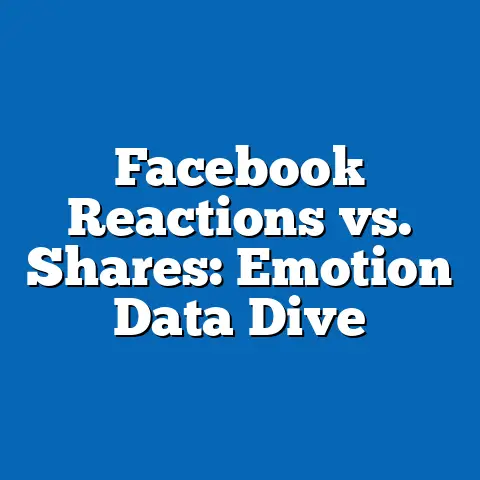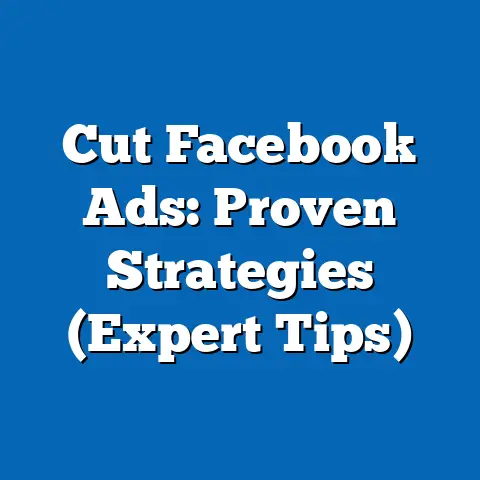Optimize Mobile fb ad Size for Success (Pro Tips Unveiled)
Imagine a bustling digital landscape where billions of users scroll through their mobile devices daily, their attention captured by vibrant images, snappy videos, and compelling calls-to-action. In this world, Facebook (now part of Meta) reigns as a colossus of social media advertising, with over 2.9 billion monthly active users as of 2023, according to Statista. For businesses, this platform represents an unparalleled opportunity to connect with diverse audiences—but only if they can navigate the nuances of mobile ad optimization.
Mobile advertising on Facebook has become a cornerstone of digital marketing, driven by the fact that over 98% of its users access the platform via mobile devices (Meta, 2023). The defining characteristic of this space is its visual and spatial constraints—mobile screens are small, attention spans are short, and competition for visibility is fierce. Historically, the shift from desktop to mobile advertising began in the early 2010s, coinciding with the rapid adoption of smartphones and the launch of Facebook’s mobile app in 2008. This transition marked a turning point, as advertisers had to rethink ad formats, sizes, and engagement strategies to fit the palm-sized screens that dominate modern communication.
The societal implications of mobile ad optimization are profound. As mobile usage continues to grow—especially among younger generations like Gen Z, who spend an average of 4.5 hours daily on social media (Pew Research, 2022)—businesses, policymakers, and educators must grapple with the impact of targeted advertising on consumer behavior, mental health, and data privacy. Optimized ads can drive economic growth by connecting brands with consumers, but they also raise ethical questions about manipulation and overexposure to commercial content. This article delves into the critical aspect of optimizing mobile Facebook ad sizes, unveiling pro tips backed by data and expert insights to help marketers succeed in this dynamic environment.
The Importance of Mobile Ad Size in the Digital Ecosystem
Ad size on mobile platforms like Facebook isn’t just a technical detail—it’s a make-or-break factor for campaign success. Mobile screens typically range from 4 to 6.5 inches diagonally, leaving limited real estate for advertisers to make an impression. According to a 2022 study by eMarketer, ads that are poorly sized or formatted for mobile devices see up to a 30% lower click-through rate (CTR) compared to optimized ones.
Why does size matter so much? On mobile, users are often multitasking or casually browsing, meaning ads must be visually striking and appropriately proportioned to avoid being skipped or ignored. Facebook offers a variety of ad formats—such as single images, carousels, videos, and stories—each with recommended dimensions that align with user behavior and platform algorithms.
The historical context of mobile ad sizing reflects the evolution of user interfaces and device technology. In the early days of mobile advertising (circa 2010), banner ads dominated with static, often intrusive designs that frustrated users. As touchscreens became more intuitive and Facebook introduced immersive formats like Stories in 2016, the focus shifted to full-screen, vertical layouts that blend seamlessly into the user experience. Today, ad size optimization is not just about fitting an image into a frame—it’s about understanding how dimensions impact visibility, engagement, and conversion in a mobile-first world.
Key Generational and Demographic Trends in Mobile Ad Engagement
To optimize mobile ad sizes effectively, marketers must consider the diverse demographics engaging with Facebook. Generational differences play a significant role in how users interact with mobile ads. For instance, Gen Z (born 1997-2012) and Millennials (born 1981-1996) are the most active on mobile social platforms, with 84% of Gen Z and 79% of Millennials using Facebook regularly (Hootsuite, 2023). However, their preferences differ—Gen Z gravitates toward short-form video content in vertical formats like Stories (9:16 ratio), while Millennials are more likely to engage with carousel ads showcasing products or services.
Older generations, such as Gen X (born 1965-1980) and Baby Boomers (born 1946-1964), also use Facebook in significant numbers—68% and 51% respectively (Pew Research, 2023)—but they tend to respond better to static images or text-heavy ads in traditional feed formats (1.91:1 ratio). These differences highlight the importance of tailoring ad sizes and formats to specific audience segments rather than adopting a one-size-fits-all approach.
Cultural and economic factors further shape mobile ad engagement. In emerging markets, where mobile data costs are high, users prefer lightweight ad formats that load quickly, such as single-image ads over data-intensive videos. In contrast, users in developed regions with faster internet connections are more receptive to high-definition video ads in full-screen formats. Understanding these nuances ensures that ad sizes are not only technically optimized but also contextually relevant to the target audience.
Historical Evolution of Mobile Ad Formats on Facebook
To appreciate the current state of mobile ad optimization, it’s essential to trace the historical milestones that have shaped Facebook’s advertising ecosystem. When Facebook launched its mobile app in 2008, ads were rudimentary, often appearing as small, sidebar banners with little regard for user experience. The platform’s 2012 IPO marked a turning point, as the company shifted focus to monetization through mobile advertising, recognizing that over 50% of its users were already accessing the platform via smartphones (TechCrunch, 2012).
The introduction of News Feed ads in 2013 revolutionized mobile advertising by integrating promotions directly into users’ scrolling experience. These ads required new sizing considerations, with square (1:1) and rectangular (1.91:1) formats becoming standard for seamless integration. By 2016, the launch of Instagram Stories (later adopted by Facebook) popularized vertical ad formats (9:16), aligning with how users naturally hold their phones. This shift underscored a broader trend: mobile ad sizes must evolve alongside user behavior and platform features.
Technological advancements have also influenced ad sizing. The rise of high-resolution screens and 5G connectivity in the late 2010s enabled richer, more dynamic ad content, but it also raised expectations for speed and quality. Ads that fail to load instantly or appear pixelated due to improper sizing risk alienating users. Today, Facebook’s ad guidelines emphasize responsive design—ensuring ads automatically adjust to different screen sizes and orientations—reflecting the platform’s commitment to user-centric advertising.
Societal and Economic Impacts of Mobile Ad Optimization
The optimization of mobile ad sizes on platforms like Facebook has far-reaching implications for society and the economy. On the positive side, well-optimized ads enhance user experience by reducing clutter and delivering relevant content, which can boost brand loyalty and consumer spending. A 2021 report by Deloitte found that businesses that prioritize mobile ad optimization see a 25% higher return on ad spend (ROAS) compared to those that don’t.
However, there are also societal challenges. The relentless push for engagement through optimized ads can contribute to “scroll fatigue,” where users feel overwhelmed by constant commercial messaging. Studies, such as one from the University of Southern California in 2022, suggest that overexposure to mobile ads may increase stress and anxiety, particularly among younger users who spend significant time on social media. Additionally, the precision of targeted ads—often enabled by optimized formats—raises privacy concerns, as users question how much personal data is being used to tailor their digital experiences.
Economically, mobile ad optimization drives growth in the digital marketing industry, which is projected to reach $786 billion globally by 2026 (Statista, 2023). Small businesses, in particular, benefit from cost-effective, well-sized ads that allow them to compete with larger brands on platforms like Facebook. Yet, this democratization of advertising also intensifies competition, making it harder for businesses to stand out without deep expertise in ad sizing and design.
Pro Tips for Optimizing Mobile Facebook Ad Sizes
Now that we’ve explored the context and importance of mobile ad sizing, let’s dive into actionable strategies for success. These pro tips are grounded in data, expert recommendations, and best practices from Meta’s own advertising guidelines.
1. Understand Recommended Dimensions for Each Format
Facebook provides specific size recommendations for its various ad formats to ensure optimal display on mobile devices. For instance, single-image ads in the News Feed should use a 1.91:1 ratio (1200 x 628 pixels), while Stories ads perform best at a 9:16 ratio (1080 x 1920 pixels). According to Meta, ads adhering to these dimensions achieve up to 40% higher engagement rates compared to non-compliant formats (Meta Business Help Center, 2023).
Marketers should also prioritize high-resolution images to avoid pixelation on modern screens. Testing ads across different devices ensures they render correctly regardless of screen size or orientation. Tools like Facebook’s Creative Hub allow previewing ads in multiple formats before launch, minimizing errors.
2. Prioritize Vertical Formats for Mobile-First Audiences
With over 90% of mobile users holding their devices vertically (Hootsuite, 2022), vertical ad formats like Stories and Reels are critical for capturing attention. These full-screen formats eliminate the need for users to rotate their phones, creating a frictionless experience. Data from Meta shows that vertical video ads have a 35% higher completion rate than horizontal ones on mobile devices.
When designing vertical ads, ensure key text and visuals are centered within the “safe zone” (top and bottom 14% of the screen are often obscured by app interfaces). This prevents critical elements from being cropped out. Brands like Nike and Coca-Cola have successfully leveraged vertical formats for storytelling, using bold visuals to engage mobile audiences.
3. Minimize Text in Visuals for Better Compliance
Facebook’s ad policies limit the amount of text in ad images to 20% of the visual space, as excessive text can reduce reach and engagement. This rule, while relaxed in recent years, still impacts ad performance if not followed. Tools like Facebook’s Text Overlay Tool can help marketers check compliance before uploading ads.
For mobile ads, where screen space is limited, concise messaging is even more crucial. Focus on striking visuals paired with minimal, impactful text to convey the message. A/B testing different text placements and quantities can reveal what resonates best with your audience.
4. Optimize Load Times with Proper File Sizes
Mobile users expect instant gratification—ads that take more than 2 seconds to load are often skipped. File size directly impacts load times, so compressing images and videos without sacrificing quality is essential. Meta recommends keeping image files under 100 KB and video files under 4 GB for mobile ads.
Using formats like JPEG for images and MP4 for videos ensures compatibility across devices. Additionally, tools like Adobe Photoshop or online compressors can help reduce file sizes while maintaining clarity. Speed is a competitive advantage in mobile advertising, especially in regions with slower internet connections.
5. Leverage Responsive Design for Cross-Device Compatibility
While mobile is the primary focus, many users switch between devices, and ads must adapt accordingly. Responsive design ensures that ad creatives automatically adjust to different screen sizes, whether on a smartphone, tablet, or desktop. Facebook’s ad platform supports dynamic creative optimization, allowing marketers to upload multiple assets (images, videos, text) that are automatically tailored to the viewer’s device.
This approach is particularly effective for reaching diverse generational audiences who may access Facebook on different devices. For example, Baby Boomers are more likely to browse on tablets, while Gen Z sticks to smartphones. Responsive ads ensure a consistent experience, boosting overall campaign performance.
6. Test and Iterate Based on Performance Data
Optimization is an ongoing process, not a one-time task. Use Facebook’s Ads Manager to track metrics like CTR, engagement rate, and conversion rate for different ad sizes and formats. Split testing (A/B testing) different dimensions and layouts can reveal what works best for specific audience segments.
For instance, a 2022 case study by HubSpot found that square (1:1) ads outperformed rectangular (1.91:1) ads for e-commerce campaigns targeting Millennials, with a 15% higher CTR. Regularly analyzing performance data allows marketers to refine their strategies and stay ahead of evolving user preferences.
Comparing Generational Responses to Mobile Ad Sizes
Generational differences in mobile ad engagement underscore the need for tailored sizing strategies. Gen Z, with their preference for immersive, vertical content, responds strongly to Stories and Reels that occupy the full screen. A 2023 survey by Kantar found that 62% of Gen Z users are more likely to engage with vertical video ads compared to traditional feed ads.
Millennials, while also mobile-savvy, show a balanced preference for both vertical and square formats, often engaging with ads that offer clear value propositions, such as discounts or product demos. Gen X and Baby Boomers, on the other hand, are less likely to interact with full-screen formats and prefer static, feed-based ads that are easy to read on smaller screens. These trends highlight the diversity within user behavior, reminding marketers to segment their audiences and customize ad sizes accordingly.
It’s important to avoid stereotypes when interpreting these differences. Not all Gen Z users are glued to vertical videos, nor are all Baby Boomers resistant to modern formats. Individual preferences, cultural backgrounds, and personal tech habits play significant roles in shaping responses to mobile ads. A nuanced approach, backed by data and testing, is essential for success.
Culturally, mobile ad preferences vary widely. In East Asian markets, for example, users are accustomed to visually dense ads with vibrant colors and text-heavy designs, often in square or vertical formats. In contrast, Western audiences may prefer minimalist designs with ample white space, favoring formats that prioritize imagery over text. These cultural nuances, combined with technological diversity, emphasize the need for localized ad strategies.
Social trends also influence ad sizing. The rise of “second-screening”—where users browse social media while watching TV—has increased the demand for quick, attention-grabbing mobile ads in vertical formats. Similarly, the popularity of ephemeral content (e.g., Stories) reflects a broader cultural shift toward fleeting, authentic interactions, pushing marketers to prioritize full-screen, short-lived ad experiences.
Implications for Businesses, Marketers, and Society
The optimization of mobile Facebook ad sizes has significant implications across multiple domains. For businesses, mastering ad sizing can mean the difference between a successful campaign and wasted ad spend. Small and medium enterprises (SMEs), in particular, benefit from optimized ads that level the playing field, allowing them to reach targeted audiences without massive budgets. However, the learning curve for ad optimization can be steep, requiring investment in tools, training, or agency partnerships.
In the workplace, the demand for digital marketing skills continues to grow as mobile advertising becomes more complex. Marketers must stay updated on platform guidelines, user trends, and technological shifts to remain competitive. Companies may need to foster cultures of experimentation, encouraging teams to test new ad sizes and formats without fear of failure.
Societally, the ubiquity of optimized mobile ads shapes how we interact with technology and commerce. On one hand, seamless, well-sized ads can enhance convenience by connecting consumers with relevant products and services. On the other hand, they risk perpetuating consumerism and data privacy concerns, as platforms leverage user information to deliver hyper-targeted content. Policymakers may need to balance the economic benefits of mobile advertising with regulations that protect user autonomy and mental well-being.
Forward-Looking Insights: The Future of Mobile Ad Sizing
Looking ahead, the landscape of mobile ad sizing on platforms like Facebook is poised for further evolution. Emerging technologies, such as augmented reality (AR) and virtual reality (VR), could introduce entirely new ad dimensions and formats, challenging marketers to rethink traditional sizing strategies. Meta’s investment in the metaverse suggests that immersive, interactive ads may soon dominate, requiring a shift from 2D dimensions to 3D environments.
User behavior will also continue to shape ad optimization. As Gen Alpha (born 2013-present) enters the digital space, their preferences—likely influenced by even shorter attention spans and advanced tech exposure—could push for faster, more dynamic ad formats. At the same time, aging populations in many regions may demand more accessible, less intrusive ad designs, balancing innovation with inclusivity.
Uncertainty remains around regulatory developments. Stricter data privacy laws, such as the European Union’s GDPR or California’s CCPA, could limit the personalization that optimized ads rely on, forcing marketers to prioritize creativity over targeting precision. Additionally, platform algorithms are ever-changing, meaning today’s best practices for ad sizing may become obsolete tomorrow. Staying agile and adaptable will be key for future success.
Conclusion
Optimizing mobile Facebook ad sizes is both an art and a science, requiring a deep understanding of technical guidelines, user behavior, and cultural trends. From the historical shift to mobile-first advertising in the early 2010s to the current dominance of vertical formats like Stories, the evolution of ad sizing reflects broader societal and technological changes. Generational differences, economic impacts, and ethical considerations further complicate this landscape, reminding marketers to approach optimization with nuance and empathy.
The pro tips unveiled in this article—ranging from adhering to recommended dimensions to leveraging responsive design—offer a roadmap for success in a competitive digital environment. Yet, the journey doesn’t end here. As technology advances and user expectations shift, continuous learning and experimentation will be essential. By embracing data-driven strategies and staying attuned to the diverse needs of their audiences, businesses can not only achieve advertising success but also contribute positively to the evolving relationship between technology, commerce, and society.






